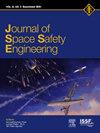MAS—A mission analysis software for collision risk quantification and impact assessment of rule-based decision-making for collision avoidance
IF 1.7
Q3 ENGINEERING, AEROSPACE
引用次数: 0
Abstract
The growing number of operational spacecraft in orbit around Earth results in an increasing operational effort for collision avoidance (COLA), particularly concerning the coordination of COLA measures. In order to cope with this increased effort, the automation of future COLA operations is therefore indispensable. The Mission Analysis Software (MAS) is a web-based application developed at the Technical University of Darmstadt within the project collision avoidance, satellite coordination assessment demonstration environment (CASCADE) which is funded by the European Space Agency (ESA). The MAS promotes a rule-based approach for the automation of COLA coordination within the space community by providing analyses based on data-driven simulations.
To this end, the MAS enables satellite operators to quantify the risk related to conjunctions involving other active satellites for operational or planned missions. In addition, users of the MAS can conduct a rule analysis showing the impact of incorporating a rule-based coordination approach into operations. To achieve this, users can assemble hierarchical rule sets from pre-defined customisable rule building blocks. The MAS evaluates the operational consequences of a chosen rule set, empowering users to reach bilateral and multilateral agreements with frequently conjuncting parties. With these agreements the obligation to conduct COLA manoeuvres can be assigned automatically for future conjunctions.
This approach allows for the preemptive reduction of the expected number of conjunctions enabling operators to optimise orbit parameters within their mission constraints as well as the automation of COLA coordination during operations. Through this, the MAS optimises propellant needs, mission time, and required workforce associated with COLA for space missions.
This paper presents the MAS, highlighting key features developed in close collaboration with stakeholders and the European Space Agency. The workflow for utilising the MAS is briefly outlined, while the primary emphasis of the paper is on detailing the conjunction assessment approach of the MAS.
For this purpose, the paper presents the uncertainty estimation model of the MAS which is designed to estimate positional uncertainties of satellites based on data from ESA’s Kelvins collision avoidance data challenge. Subsequently, the methodology of the MAS for deriving avoided and remaining risk values and estimated number of manoeuvres for a simulated mission from this uncertainty data is explained showing how operational aspects of COLA are integrated into this process. Lastly, results of the MAS are presented and validated with data from ESA’s DRAMA tool suite.
基于规则的避碰决策的碰撞风险量化与影响评估任务分析软件
由于在地球轨道上运行的航天器越来越多,因此在避免碰撞方面的业务努力也越来越多,特别是在协调避免碰撞措施方面。因此,为了应付这种增加的努力,未来的COLA业务的自动化是必不可少的。任务分析软件(MAS)是一个基于网络的应用程序,由达姆施塔特工业大学在欧洲空间局(ESA)资助的项目碰撞避免、卫星协调评估演示环境(CASCADE)中开发。MAS通过提供基于数据驱动的模拟的分析,促进了一种基于规则的方法,使空间界的COLA协调自动化。为此目的,MAS使卫星运营商能够量化与涉及其他活动卫星的业务或计划任务相关的风险。此外,MAS的用户可以进行规则分析,显示将基于规则的协调方法纳入操作的影响。要实现这一点,用户可以从预定义的可定制规则构建块中组装分层规则集。MAS评估所选规则集的操作后果,使用户能够与经常合并的各方达成双边和多边协议。有了这些协议,进行COLA演习的义务可以自动分配给未来的连接。这种方法允许先发制人地减少预期的连接数量,使运营商能够在其任务约束范围内优化轨道参数,并在操作期间实现COLA协调的自动化。通过这一点,MAS优化推进剂需求、任务时间和与空间任务的COLA相关的所需劳动力。本文介绍了MAS,突出了与利益攸关方和欧洲航天局密切合作开发的关键特征。简要概述了利用MAS的工作流程,而本文的主要重点是详细介绍MAS的联合评估方法。为此,本文提出了基于欧空局开尔文避碰数据挑战的MAS不确定性估计模型,该模型旨在估计卫星的位置不确定性。随后,解释了MAS从这种不确定性数据中得出可避免和剩余风险值以及模拟任务的估计机动次数的方法,展示了COLA的操作方面如何集成到这一过程中。最后,给出了MAS的结果,并使用ESA的DRAMA工具套件的数据进行了验证。
本文章由计算机程序翻译,如有差异,请以英文原文为准。
求助全文
约1分钟内获得全文
求助全文
来源期刊

Journal of Space Safety Engineering
Engineering-Safety, Risk, Reliability and Quality
CiteScore
2.50
自引率
0.00%
发文量
80
 求助内容:
求助内容: 应助结果提醒方式:
应助结果提醒方式:


